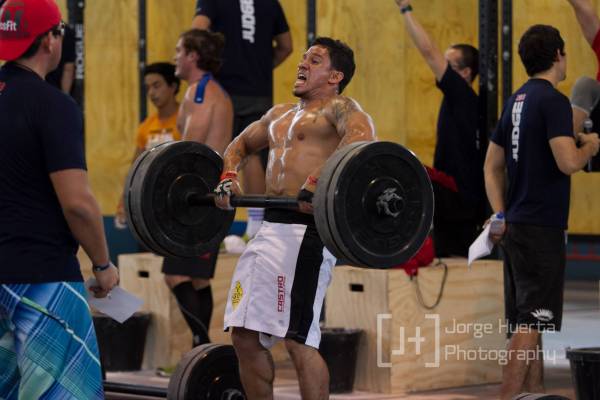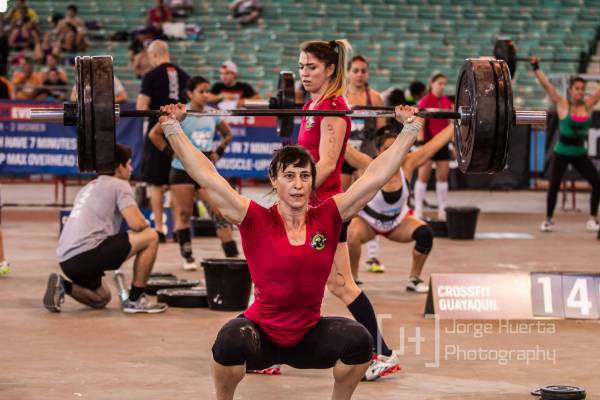There is a link at the end of this article that will lead you to a site where you can donate to Kevin’s medical fund.
Kevin Ogar of CrossFit Unbroken is paralyzed from the waist down. He was participating in the OC Throwdown. According to spectator accounts, it was during a 3RM touch-and-go snatch workout that Kevin failed a snatch behind, falling backwards into a sitting position. The bar then struck a pile of 45lb plates stacked behind the platform and bounced back and struck Kevin. It damaged his T11 and T12 vertebrae and severed his spinal cord.
As of this writing, Kevin has no feeling below the waist. I hope and pray this changes.
How Do We Honor Kevin Ogar?
Here is a kid who by all accounts was a super coach, was a gifted athlete, and had his whole life ahead of him. In what can best be described as a freak accident, his career was cut short and he may never walk again.
But was it a freak accident? It’s natural to want to ascribe this to a one-in-a-million situation that could have happened to anyone at anytime. After all, Olympic weightlifters fail reps all the time and it’s no secret that bars fall on those athletes. Olympic gold medalist Mathhias Steiner failed a snatch in the 2012 London Games and the bar, weighing 432lbs came crashing down directly on his neck. He was lucky. He walked away.
There is a common theory in aviation accident investigation that most airplane crashes are not the result of a single, catastrophic event, but rather, a series of smaller, almost insignificant events that all lead to the crash. And in that chain, without one of those links, the crash would not have occurred. Yes, there is always a named cause – “pilot failed to maintain clearance from obstacle resulting in wing strike” – but usually the chain of events starts much, much earlier. Pilot doesn’t get enough sleep, runs late to the airport, pre-flight check is rushed, lack of sleep results in slight lack of focus, and so on. All of those minor incidents create a chain, and at the end of that chain is a catastrophic collision.
We need to start considering the possibility in Kevin’s accident that there was a chain of events, any link of which may have simply allowed the event to continue injury free, had that link been removed. Now, please read this caveat carefully: I am not in any way suggesting this is Kevin’s fault. Should you be tempted to read blame here, you would be reading incorrectly. There is a big difference between determining cause and assessing blame. What I seek is to start a dialog where we can examine the links in the chain of events that led to this horrible accident. And if that dialog leads to the kind of self-examination that allows for discussion to bring about some positive change, so be it.
How do we honor Kevin Ogar? We talk about what happened.
Contrary to some of the “how-dare-you” posts on Facebook and other social media suggesting that I and others were disrespecting Kevin by bringing up causation while he was still in surgery, I would suggest that right now is exactly the time to talk about it. Remaining mute on the topic does Kevin no good whatsoever, and building a protecting wall around the sport only serves to put off the inevitable. It’s a conversation we must have. What happened? And could it have been prevented?
CrossFit Competitions Are Different
 CrossFit competitions are different then weightlifting meets. At weightlifting meets, lifters execute exactly six lifts with sufficient rest in between. Three snatches, three clean and jerks. CrossFit competitions, especially those of the notoriety of the OC Throwdown, serve up day after day of brutal workouts. In 2010 this event had four workouts. In 2014, there were nine workouts, and if you count the three individual workouts that comprised the ninth workout, there were actually eleven total. The snatch workout in which Kevin was injured was the eight workout of the weekend.
CrossFit competitions are different then weightlifting meets. At weightlifting meets, lifters execute exactly six lifts with sufficient rest in between. Three snatches, three clean and jerks. CrossFit competitions, especially those of the notoriety of the OC Throwdown, serve up day after day of brutal workouts. In 2010 this event had four workouts. In 2014, there were nine workouts, and if you count the three individual workouts that comprised the ninth workout, there were actually eleven total. The snatch workout in which Kevin was injured was the eight workout of the weekend.
What we have seen in these weekend competitions is a trend toward ass-kicking beat-downs. I have experienced it. So have many others. What started as tests of fitness have now almost become tests of sheer force of will. Sheer survival. One of the workouts at the OC Throwdown was even called Welcome to Hell.
What happens to athletes who go through a series of tortuous workouts day after day is that their central nervous system begins to suffer. Many CrossFitters will refer to this as their “CNS being trashed.” Every workout requires athletes to dig, hard, into their energy systems to properly provide fuel, muscle contraction, and neurological firing to perform. Think of your body as a battery. After workout number one, you’ve depleted your battery to, say, 80%. You can rest between workouts and refuel, but you will not, under any circumstances, begin workout number two with a 100% recharged battery. Your body doesn’t work that way.
Maybe the rest between WODS and the refueling brings you back to 95%, which is sufficient for the next workout. The pattern continues until workout number eight. By this time, and presumably on day three of the OC Throwdown, an athlete’s CNS is sufficiently battered such that there will be effects. Those effects may be manifested as complete exhaustion, or something much more subtle, like a slower reaction time.
A slower reaction time for something as technical as a very heavy snatch may be the difference between making the lift and missing the lift. Anyone who has ever snatched knows the feeling of things not clicking. Imagine trying to execute this lift with 235lbs on day three of a brutal series of workouts.
Link #1: Programming
So perhaps it’s plausible to say that link number one in the chain of events is programming. Programming that is sufficiently difficult so as to take the edge off even the best athlete’s game by day three, depleting the battery and leaving the reaction time slowed.
I am not saying this is what occurred. I am introducing it as a possibility. This trend of brutality-based workouts in competitions is concerning. Think about it: the CrossFit Games began as a two-day, four-workout campfire. It has now grown to no less than five days of competitive events, many of which would stand alone as a competition. Many of these larger weekend throwdowns are following suit. Why?
Because the only way to attract the big talent, the big sponsors, and the big crowds is to serve up a bigger event with more hype, more swearing, more torn calluses, and more blood. We’re verging on gladiator mentality when we market events with “nine bone-crushing WODS that will leave you on the floor begging for mercy.”
The challenge to event organizers is simple. Remember what you’re testing: fitness.
Link #2: Organization
Link number two in the chain may well be the placement of the plates. A stack of four 45lb plates sat directly behind the platform on which Kevin was lifting. Now, in a perfect world, there would not be any plates within striking distance of a falling bar. We all know the violent whiplash that a bar striking an odd-shaped object on the floor can have. What ordinarily is a subtle bounce off the floor becomes a violent ricochet.
It appears that the bar fell behind Kevin as he fell into a seated position, hit the plates and bounced back directly into his back. I have seen the video and what you see is the bar hit the plates, the plates shift, and a split second later, Kevin reacts sharply and violently, as though he’s been shot. The decision to place plates so close to the lifter can potentially be identified as a link in the chain. Remove the plates, remove the link, and the accident doesn’t happen – if, in fact, it was the bounce off the plates that caused the injury. We may never know.
There are likely many other, small, almost imperceptible links in the chain – human decisions that were made on that day that, but for the full chain of events, would likely have allowed Kevin’s day to go on just like any other. Accidents will happen. But it is our duty to vigorously examine the cause of those accidents to ascertain why they occurred and do whatever it takes to make sure it doesn’t happen again.
Again, I Ask: How Do We Honor Kevin Ogar?
By making sure.
By asking the hard questions.
By demanding some logic and accountability on the part of event organizers to think. To create a vision for events that showcases the true talents of CrossFit athletes – a vision that does not create a last-man-standing culture that requires athletes to be beaten to a pulp.
By insisting that event organizers stop trying to top last year’s adjective with a newer, more hyperbolic one.
 By working diligently to ensure that whenever possible, to the extent possible, the chain is broken. That redundant safety measures are put into place. That contingencies are planned for. And that these event organizers, many of whom may be in well over their heads by virtue of the sheer explosive growth of the events themselves, put athletes over ego, safety over hype, and invest in learning how to create an event that allows everyone to walk away feeling as though the fittest person prevailed.
By working diligently to ensure that whenever possible, to the extent possible, the chain is broken. That redundant safety measures are put into place. That contingencies are planned for. And that these event organizers, many of whom may be in well over their heads by virtue of the sheer explosive growth of the events themselves, put athletes over ego, safety over hype, and invest in learning how to create an event that allows everyone to walk away feeling as though the fittest person prevailed.
We have a man down. Burying our heads in the sand dishonors him. Digging deep to locate the weak link in the chain honors not only him, but protects those who aspire to be like him.
Kevin’s medical bills will run into the hundreds of thousands of dollars, if not a lifetime of bills. Here is your chance to come together in the spirit of community and donate, even a little, to help defray the skyrocketing cost of his medical expenses. You can donate here.
Photos provided by Jorge Huerta Photography.






